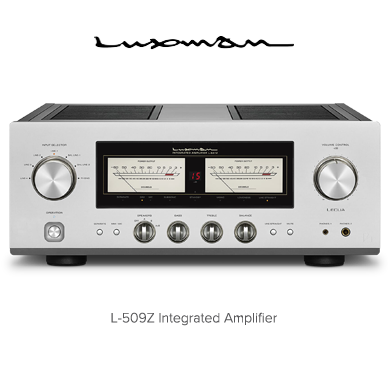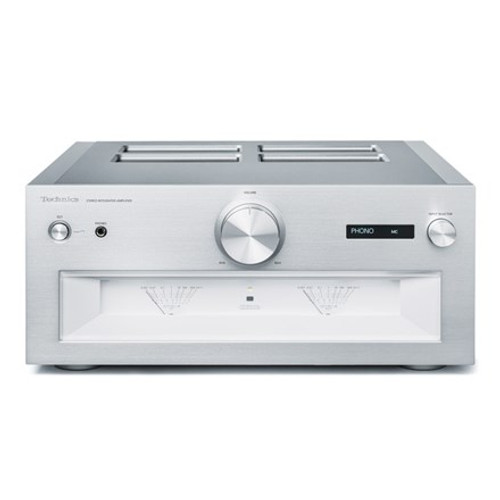Advancing Performance Via Cutting-Edge Technology: Technics SU-R1000 Integrated Amplifier Features Four Independent Power-Supply Units, Superb MM/MC Phono Preamp
The technology behind the SU-R1000, the first Reference Class integrated amplifier in Technics history, is so sophisticated and advanced, it often takes the form of acronyms: ADCT, LAPC, JENO, ASSPS. Above all, however, SU-R1000 functions as a model of simplicity in the involving manners in which it delivers music playback and affords you, the listener, incredible control and easy operation. The statement-making appearance factors in as a kind of bonus — a visual reward for investing in a component that stops at nothing when it comes to immersive, emotional, high-end fidelity — and what it takes to get there.
Equipped with brand-new Active Distortion Cancelling Technology (ADCT) — which realizes the further enrichment of the sonic presentation by eliminating distortion generated in the power stage by the speaker's counter electromotive force and a power supply voltage drop — as well as a new Advanced Speed Silent Power Supply (ASSPS) that enables a stunning S/N ratio, SU-R1000 also boasts four independent power-supply units for differential circuit blocks, enabling wowing instrumental separation and massive dynamic swings. Moreover, in the power output section, SU-R1000 employs a high-speed GaN (gallium nitride) FET driver device with super-low resistance. The approach allows for single push-pull configuration, permitting the length of the large-current carrying signal path to get shortened and result in outstanding linearity regardless of the sound level.
From a user-functional perspective, SU-R1000 touts a wealth of inputs and outputs, chiefly among which are two USB-B inputs and a stupendous MM/MC phono preamplifier with XLR input. Dubbed Intelligent Phono EQ, the latter features a cutting-edge build with three parts: accurate EQ curve achieved via a hybrid analog-digital system; crosstalk canceller that measures your cartridge's crosstalk and performs reverse-correction with built-in DSP; and response optimizer, which measures the cartridge's frequency characteristic and corrects any disturbance and the effect of impedance matching. All three can be turned off, depending on your preferences.
We invite you to read more about the pioneering architecture and technology invested in SU-R1000 below, or, simply gaze at the images of this truly premium piece. Better still, order to audition one in your home backed by the security of our Satisfaction Guarantee and experience the Technics difference.
"It is truly innovative, and should help rebut any lingering prejudice against both digital and integrated amplifiers. Accordingly, I'd give the same kind of recommendation that the Michelin Guide gives to its few, top-rated, three-star restaurants: They are all different, but they are also all 'exceptional and worth a special journey.' The SU-R1000 is the kind of product that makes the high end fun!"
—Anthony H. Cordesman, The Absolute Sound,Golden Ear Award
"Any fears that the use of digital circuitry would lead to a cold and analytical sound vanish early on. Once the LAPC process is carried out (just press the button and wait a few minutes), the SU-R1000 has a big-boned and generous presentation.... Our verdict: Technics' top integrated amplifier is a breathtakingly ambitious technological marvel, and an entertaining listen, too."
—What Hi-Fi?
"The SU-R1000 framed recordings, especially vintage vinyl, in their unique, historic time, to a greater extent than any amplifier I'd previously heard. Through the Technics, the constituent ingredients of each recording were shaped and arranged in seemingly perfect order as though snapped to attention by an invisible hand. The SU-R1000 may be technically complex, but its sound was simple, whole, and true with exceptional transparency, flow, and imaging."
—Ken Micallef, Stereophile, Class A Recommended Component
"Technics has filled this integrated amplifier with intellectual capital in the service of music in a manner I'm not so sure is available elsewhere, regardless of budget. If effortless power, startling dynamics, and unwavering clarity from digital and analog sources (especially records!), are high on your want list, the SU-R1000 should be very high on that list as well."
—Michael Lavorgna, Twittering Machines
"I had no issue with the means by which Technics achieved the sound quality produced by the SU-R1000; instead, I found myself admiring its daring, cutting-edge design and outstanding performance with both analog and digital sources. I would love to have one of these fine-sounding beauties alongside a Technics SL-series turntable in my system!"
—Roger Kanno, SoundStage! Hi-Fi
"Technics has hit it out of the park. The SU-R1000 stands on its own as a truly reference-caliber product that ranks among the best that I've heard when it comes to just sheer musical enjoyment. I absolutely love it!"
—Andrew Robinson, The Recovering Audiophile (YouTube)
JENO (Jitter Elimination and Noise-Shaping Optimization)
Jitter is a major cause of distortion in digital systems, and is caused by mis-timing in the master clocks used in digital-to-analogue conversion. To eliminate the degradation of sound caused by jitter, Technics has developed an original jitter reduction circuit, comprising a clock generator in the noise-shaping system to reduce jitter in the low-frequency range and a high-precision sample rate converter for suppressing jitter in the high-frequency range. It reduces jitter in an ideal way over the entire frequency range. This works with an original high-precision PWM (Pulse Width Modulation) conversion circuit, optimizing the noise-shaping speed, the degree and re-quantization number, and the PWM gradation, in order to convert high-resolution signals to PWM without causing any damage to the dynamic range. These technologies enable Technics amplifier designs to reproduce the natural and delicate nuances of music.
LAPC (Load Adaptive Phase Calibration)
Speaker impedance changes with each frequency, and a power amplifier is required to drive speakers without being affected by the speaker's characteristics. However, conventional digital amplifiers are connected to speakers through a low-pass filter at the output stage, so they are even more strongly affected by the speaker impedance characteristics. Also, although the amplitude characteristics of conventional amplifiers due to negative feedback were improved, the phase characteristics could not be enhanced. Technics thus developed a speaker impedance adaptive optimization algorithm that performs correction to the ideal impulse response through digital signal processing by measuring the frequency amplitude-phase characteristics of the amplifier with the speakers connected. This new technique enables flattening the frequency characteristics of amplitude and phase, which had previously not been achieved by amplifiers, as well as delivering a sound with rich spatial expression.
ADCT (Active Distortion Cancelling Technology)
The Active Distortion Cancelling Technology newly developed by Technics accurately extracts and removes distortion in the power output stage that is generated by the speaker's counter electromotive force and voltage drops. In an audio market where an unlimited number of audio systems can be configured by combining various products, high-end audio amplifiers need to drive a diversity of speakers to the fullest. The Active Distortion Cancelling Technology accurately extracts distortion by determining the difference between the speaker terminal output and JENO output and then applies correction to the output digital signal, thus correcting the conventional digital amp system. This provides powerful, speaker-driving force and acoustic energy while offering the superior features of a digital amp, such as low noise, sharp sound image, and expansive sound ambience, regardless of the type of connected speakers.
Advanced Speed Silent Power Supply
SU-R1000 uses a switching power supply system to ensure stable supply of voltage and current required by the digital amp. In a conventional switching power supply system, the ON time of the switching operation was controlled in order to stabilize the voltage, and this caused the switching frequency to fluctuate according to the load, resulting in a modulation noise to affect the sound quality. The Advanced Speed Silent Power Supply has eliminated this noise by fixing the switching frequency in the 400kHz band. Furthermore, a Super Low Noise Regulator is provided in the later stage. This prevents the decrease of regulation resulting from the fixed switching frequency and impedes the mixing of noise into high frequencies.
Four Independent Power Supply Units
In SU-R1000, every element comprising the power supply has been revamped for higher sound quality. What's more, four independent power supply units are provided for different circuit blocks for further enhancement of sound quality. Since SU-R1000 is an integrated amplifier, the internal circuits consist of a preamp stage and power amp stage in a mix of analog and digital circuits. The Phono-EQ section that processes minute analog signals is particularly susceptible to the effect of noise transmitted through the power supply line. SU-R1000 uses separate power supply units for the analog circuits and digital circuits in the preamp stage. It also uses separate power supply units for the right and left channels in the power amp stage that requires large electrical power. With the four independent power supply units, SU-R1000 prevents power-line-induced interference among the circuit blocks and realizes a high S/N ratio and superb separation.
Battery-Driven Clock Generator
For a digital amplifier, improving the precision of the clock, which provides the important operation timing information, is the key to high sound quality. However, power supply noise from the clock circuit is a major impeding factor. SU-R1000 is equipped with a Battery-Driven Clock Generator. The use of a battery as a power supply for the clock circuit eliminates the adverse effect of power supply noise on the clock signal, thus enabling superb sound image localization and clear sound space expression.
GaN-FET Driver (High-Speed and Low-Impedance Power Devices)
In the power output section of the amplifier, Technics employs a high-speed GaN (gallium nitride) FET driver device with super-low resistance. This enables the construction of a high-power amp using a single push-pull configuration, allowing the length of the large current carrying signal path to be shortened, and resulting in outstanding linearity regardless of the sound level.
Intelligent Phono EQ
The Intelligent Phono EQ mounted in the SU-R1000 utilizes the sound quality improvement technology for DSP, which Technics has accumulated through the development of LAPC, in order to realize high sound quality not possible with analogue Phono-EQ. This technology consists of three parts: 1) an Accurate EQ Curve, 2) a Crosstalk Canceller, and 3) a Response Optimizer. These functions can be turned ON/OFF to suit the user's preference.
Accurate EQ Curve
Accurate EQ curve is achieved by a hybrid analog-digital system. The high-gain low-pass filter (LPF) performs analog processing, and high frequencies are raised after the A/D conversion. The use of the 40dB LPF in the analog region suppresses the bit loss during digital filter processing, and high frequencies are raised with high accuracy in the digital region to achieve a high S/N ratio.
Crosstalk Canceller
This function measures the crosstalk characteristic of the installed cartridge by using the crosstalk measuring signal recorded on the Calibration Record bundled with SU-R1000 and then performs reverse-correction using the built-in DSP to achieve significant improvement of the crosstalk characteristic. This results in sharper sound image and more expansive sound ambience.
Response Optimizer
This function measures the frequency characteristic of the installed cartridge by using a TSP (Time Stretched Pulse) signal recorded on the bundled Calibration Record, and corrects characteristic disturbance. It corrects the effect of impedance matching between the cartridge and phono equalizer to bring out the true sound quality of the cartridge. This technology aims to improve sound quality by providing a selector such as a switch in the high-sensitivity phono input line for the removal of the possibility of noise mixing.
150W + 150W ( 1kHz, T.H.D. 0.5 %, 8Ω, 20kHz LPF ),
300W + 300W ( 1kHz, T.H.D. 0.5 %, 4Ω, 20kHz LPF)
Input Sensitivity / Input Impedance: LINE 200 mV / 22 kΩ, PHONO (MM) 2.5 mV / 47 kΩ, PHONO(MC) 300uV /100Ω
Frequency Response:
LINE 5 Hz-80 kHz (-3 dB, 8 Ω),
PHONO (MM) 20 Hz - 20 kHz (RIAA DEVIATION ±1 dB, 8 Ω)
DIGITAL 5 Hz - 80 kHz (-3 dB, 8 Ω)
Load Impedance: 4 Ω-16 Ω
Analog Input Terminal: LINE x 2 (LINE 1, LINE2), LINE XLR BALANCED x1, PHONO (MM/MC) x1, PHONO XLR BALANCED(MC) x1, MAIN IN x1, REC IN x1
Digital Input Terminal: Optical digital x2 (OPT 1, OPT 2), Coaxial digital x2(COAX 1, COAX 2), USB-B x2 (PC 1, PC 2)
Analog Output Terminal: PRE OUTx1, REC OUT x1
Headphone Output: Yes, Stereo Φ6.3mm
USB-DAC (USB-B): USB 2.0 high-speed, USB Audio Class 2.0, Asynchronous mode
Support Codec:
PCM: 32, 44.1, 48, 88.2, 96, 176.4, 192, 352.8, 384 kHz / 16, 24, 32 bit
DSD: 2.8 MHz, 5.6 MHz, 11.2 MHz, 22.4 MHz (ASIO Native mode only)
Power Supply: AC 120 V, 60 Hz
Power Consumption: 220 W
Dimensions (WHD): 16-15/16" x 7-17/32" x 18-3/32"
Weight: 50.3 lbs.
Accessories: Remote Control, Calibration Record, AC Cord, Owner's Manual






































